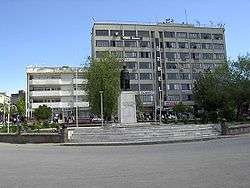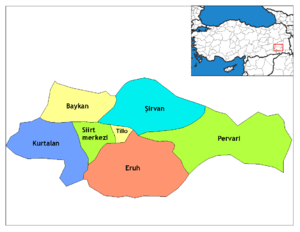Siirt
Siirt (Arabic: سِعِرْد Siʿird, Armenian: Սղերդ Sġerd, Syriac: ܣܥܪܬ, romanized: Siirt[3], Kurdish: Sêrt,[4] Ottoman Turkish: سعرد Greek: Σύρτη) is a city in southeastern Turkey and the seat of Siirt Province. The population of the city according to the 2009 census was 129,188.[5] The majority of the city's population is Kurdish.[6]
Siirt | |
|---|---|
 City center | |
 Siirt | |
| Coordinates: 37°55′30″N 41°56′45″E | |
| Country | Turkey |
| Province | Siirt |
| Government | |
| • Elected Mayor | Berivan Helen Işık (HDP) |
| • State appointed trustee | Ali Fuat Atik |
| Area | |
| • District | 283.87 km2 (109.60 sq mi) |
| Elevation | 902 m (2,959 ft) |
| Population (2012)[2] | |
| • Urban | 135,350 |
| • District | 145,784 |
| • District density | 510/km2 (1,300/sq mi) |
| Website | www.siirt.bel.tr |
History
Previously known as Saird, in pre-Islamic times Siirt was a diocese of the Eastern Orthodox Church (Sirte, Σίρτη in Byzantine Greek). In the medieval times, Arzan was the main city and it competed with Hasankeyf over the control the region, Siirt was only to become a center of the region in the 14th century. But it was still dependent from Hasankeyf until the 17th century.[7] An illuminated manuscript known as the Syriac Bible of Paris may have originated from the Bishop of Siirt's library, Siirt's Christians would worshipped in Syriac, a liturgical language descended from Aramaic still in use by the Chaldean Rite, other Eastern Christians in India, and the Nestorians along the Silk Road as far as China. The Chronicle of Seert was preserved in the city; it describes the ecclesiastical history of the Persian realm through the middle of the seventh century. From 1858 to 1915 the city was the seat of a bishop of the Chaldean Catholic Church. Most of the city's Assyrians, including Addai Scher their archbishop were killed during the Assyrian Genocide along with the loss of the Syriac manuscript of Theodore of Mopsuestia's De Incarnatione.[8]
Government
In the municipal elections of March 2019 Berivan Helen Işık of the Peoples' Democratic Party (HDP) was elected mayor.[9] She was dismissed from her post on 15 May 2020 and detained over terror charges. Ali Fuat Atik, the Governor of the Siirt province was appointed trustee by the Ministry of the Interior.[10]
Landmarks
The city's landmark is the Great Mosque (Ulu Cami) built in 1129 by the Great Seljuk Sultan Mahmut II who belonged to the main branch of the dynasty that ruled from Baghdad after this Turkish Empire had split into several branches. The mosque was restored in 1965.
Economy
Siirt was in the past a fertile agricultural environment.
Siirt is famous in Turkey for its hand-made blankets (Siirt battaniyesi). Many visitors find themselves departing with one offered as a present. The traditional kilims produced by the Jirikan clan (aşiret Arabic: عشیرة) and revived since 1996 through joint efforts involving official instances and citizens are also much prized. Another product of interest is the Bıttım soaps proper to the region. Siirt also has an extremely rich culinary and spa culture. Depending district centers of Aydınlar (former Assyrian-rooted name was Tillo) with its historical medrese is renowned as a religious center and Pervari for its honey based on the particularly rich flora.
Trivia
Siirt was Turkish Prime Minister Recep Tayyip Erdoğan's constituency from 2003 to 2007. His wife, Mrs. Emine Erdoğan, is from Siirt and the PM had been elected to the Turkish Grand National Assembly in a by-election held in Siirt in 2003.
Although Siirt remains one of the poorer cities in Turkey, some neighborhoods have fine and modern housing including new shops, banks and hotels.[11]
Climate
Siirt has a hot-summer Mediterranean climate (Köppen climate classification: Csa) with very hot and dry summers and cold and wet winters. During winter months there is frequent frost and occasional snowfall.
| Climate data for Siirt | |||||||||||||
|---|---|---|---|---|---|---|---|---|---|---|---|---|---|
| Month | Jan | Feb | Mar | Apr | May | Jun | Jul | Aug | Sep | Oct | Nov | Dec | Year |
| Record high °C (°F) | 19.7 (67.5) |
20.6 (69.1) |
28.5 (83.3) |
32.9 (91.2) |
36.2 (97.2) |
40.2 (104.4) |
44.4 (111.9) |
46.0 (114.8) |
39.9 (103.8) |
36.6 (97.9) |
25.8 (78.4) |
24.3 (75.7) |
46.0 (114.8) |
| Average high °C (°F) | 6.7 (44.1) |
8.9 (48.0) |
13.7 (56.7) |
19.4 (66.9) |
25.3 (77.5) |
32.3 (90.1) |
37.2 (99.0) |
37.0 (98.6) |
32.3 (90.1) |
24.4 (75.9) |
15.4 (59.7) |
8.8 (47.8) |
21.8 (71.2) |
| Daily mean °C (°F) | 2.8 (37.0) |
4.2 (39.6) |
8.5 (47.3) |
14.1 (57.4) |
19.6 (67.3) |
26.2 (79.2) |
30.6 (87.1) |
30 (86) |
25.1 (77.2) |
18.1 (64.6) |
10.2 (50.4) |
4.9 (40.8) |
16.2 (61.2) |
| Average low °C (°F) | −0.2 (31.6) |
0.8 (33.4) |
4.4 (39.9) |
9.3 (48.7) |
13.8 (56.8) |
19.3 (66.7) |
23.6 (74.5) |
23.3 (73.9) |
18.9 (66.0) |
12.9 (55.2) |
6.5 (43.7) |
2 (36) |
11.2 (52.2) |
| Record low °C (°F) | −19.3 (−2.7) |
−16.5 (2.3) |
−13.3 (8.1) |
−4.1 (24.6) |
2.0 (35.6) |
8.2 (46.8) |
13.1 (55.6) |
14.4 (57.9) |
8.5 (47.3) |
0.3 (32.5) |
−6.6 (20.1) |
−14.6 (5.7) |
−19.3 (−2.7) |
| Average precipitation mm (inches) | 83.2 (3.28) |
98.0 (3.86) |
104.7 (4.12) |
109.4 (4.31) |
60.2 (2.37) |
8.7 (0.34) |
1.9 (0.07) |
1.0 (0.04) |
4.7 (0.19) |
47.7 (1.88) |
79.6 (3.13) |
92.9 (3.66) |
692 (27.25) |
| Average rainy days | 11.5 | 12.0 | 13.8 | 13.5 | 10.3 | 3.4 | 0.8 | 0.6 | 1.7 | 8.1 | 9.1 | 11.7 | 96.5 |
| Average relative humidity (%) | 70 | 70 | 59 | 56 | 52 | 33 | 25 | 23 | 28 | 46 | 61 | 69 | 49 |
| Mean monthly sunshine hours | 111.6 | 123.2 | 173.6 | 201 | 285.2 | 354 | 384.4 | 359.6 | 306 | 226.3 | 156 | 108.5 | 2,789.4 |
| Source 1: Devlet Meteoroloji İşleri Genel Müdürlüğü[12] | |||||||||||||
| Source 2: Weatherbase[13] | |||||||||||||
Gallery
 A bridge in Siirt
A bridge in Siirt Ebul Vefa Mosque
Ebul Vefa Mosque Ibrahim hakkı shrine in Siirt Tillo
Ibrahim hakkı shrine in Siirt Tillo.jpg) The city hall
The city hall Siirt Tillo
Siirt Tillo Siirt Street scene
Siirt Street scene Siirt Saat Kulesi
Siirt Saat Kulesi Siirt Market area
Siirt Market area Siirt Market area
Siirt Market area Siirt Market area
Siirt Market area Siirt tiftik battaniye
Siirt tiftik battaniye Siirt House
Siirt House Siirt Ulu Camii
Siirt Ulu Camii Hacı Abdulhakim Sancak Carşı Camii
Hacı Abdulhakim Sancak Carşı Camii Hacı Abdulhakim Sancak Carşı Camii Minber
Hacı Abdulhakim Sancak Carşı Camii Minber
References
- "Area of regions (including lakes), km²". Regional Statistics Database. Turkish Statistical Institute. 2002. Retrieved 2013-03-05.
- "Population of province/district centers and towns/villages by districts - 2012". Address Based Population Registration System (ABPRS) Database. Turkish Statistical Institute. Retrieved 2013-02-27.
- Thomas A. Carlson et al., “Siirt — ܣܥܪܬ ” in The Syriac Gazetteer last modified December 9, 2016, http://syriaca.org/place/188.
- Adem Avcıkıran (2009). Kürtçe Anamnez Anamneza bi Kurmancî (PDF) (in Turkish and Kurdish). p. 57. Retrieved 17 December 2019.
- Şehir, belde ve köy nüfusları – 2009 Archived October 4, 2011, at the Wayback Machine, Tuskish Institute of Statistics
- Watts, Nicole F. (2010). Activists in Office: Arabic and Kurdish Politics and Protest in Turkey (Studies in Modernity and National Identity). Seattle: University of Washington Press. p. 167. ISBN 978-0-295-99050-7.
- Sinclair, T. A. (1989-12-31). Eastern Turkey: An Architectural & Archaeological Survey, Volume III. Pindar Press. p. 295. ISBN 978-0-907132-34-9.
- Gaunt, David; Beṯ-Şawoce, Jan (2006), Massacres, resistance, protectors: Muslim-Christian relations in Eastern Anatolia during World War I, Gorgias Press LLC, pp. 251–253, ISBN 978-1593333010 External link in
|title=(help) - "Siirt Seçim Sonuçları - 31 Mart 2019 Yerel Seçimleri". www.sabah.com.tr. Retrieved 2020-05-15.
- "Four mayors detained over alleged terror links - Turkey News". Hürriyet Daily News. Retrieved 2020-05-15.
- Siirt in South East Turkey Photo Gallery by Dick Osseman at. Pbase.com. Retrieved on 2011-04-16.
- İl ve İlçelerimize Ait İstatistiki Veriler- Meteoroloji Genel Müdürlüğü Archived January 19, 2011, at the Wayback Machine. Dmi.gov.tr. Retrieved on 2011-04-16.
- http://www.weatherbase.com/weather/weatherall.php3?s=1271&refer=&units=us&cityname=Siirt-Turkey
